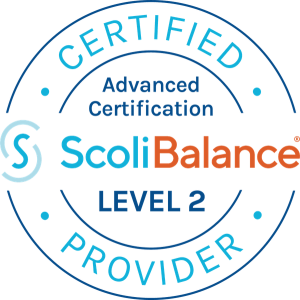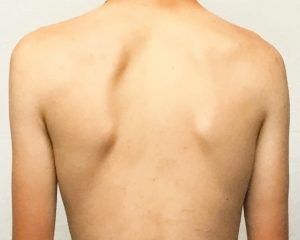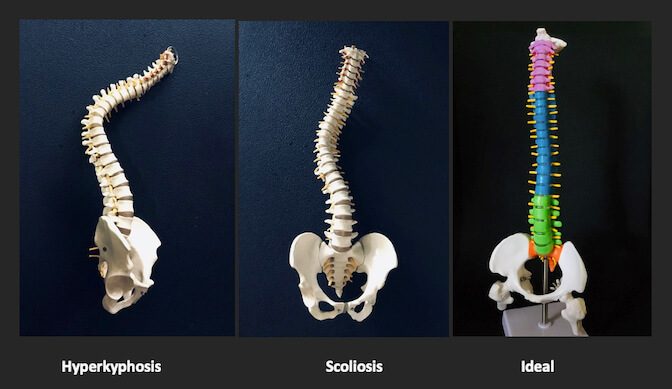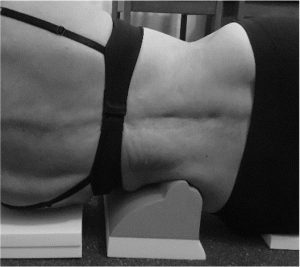Scoliosis & Chiropractic

What is scoliosis?
Scoliosis is an abnormal curve of the spine. This includes both lateral (sideways) translation and Kyphosis (increased thoracic curve or “hump”).
Scoliosis occurs most often during the growth spurt at the beginning of puberty, between 10-15years of age.
During growth spurts progression of these curves can occur much faster than at other stages of life.
For this reason, regular assessments during this period is recommended to best prevent progression. In some individuals these curves will degenerate or increase as they age.
 As an Advanced Certified ScoliBalance (level 2) Provider Dr Margaret (chiro) has received extensive training for practical assessment and ongoing patient guidance as needed, to ensure optimal patient outcomes.
As an Advanced Certified ScoliBalance (level 2) Provider Dr Margaret (chiro) has received extensive training for practical assessment and ongoing patient guidance as needed, to ensure optimal patient outcomes.
In adults with a degenerative aspect to the scoliosis, progression of the curve may also be of concern in addition to pain.
While ScoliBalance is very helpful in pain management, it may also aid in slowing the progression of a degenerative curve. However, ScoliBracing may be recommended.
When this is clinical indicated, Dr Margaret (chiro) will refer you to the team at ScoliCare.
Studies indicate approximately 40% of adults with scoliosis will have a progressive (degenerative) curve.
Degenerative scoliosis occurs most frequently in the lumbar spine (lower back), associated pain increases gradually and is often aggravated by activity.
More commonly noticed by people age 65 and older, it is often accompanied by narrowing of the spinal canal, which pinches the spinal nerves and can impair normal function.
 Indicators of possible scoliosis include:
Indicators of possible scoliosis include:
- Head is not centred (over the pelvis)
- Uneven shoulders
- Thoracic (rib) hump
- Asymmetrical hips (sometimes noticed with uneven hem line)
- The body leans to one side
Scoliosis Care
ScoliBalance is a unique physiotherapeutic scoliosis specific exercise (PSSE) program designed to address scoliosis and kyphosis in individuals of all ages, from children to adults.
It utilizes a 3D approach to manage scoliosis tailored to each patient’s individual needs, based on their curve type, symptoms, and treatment goals.
The program is the result of the combined expertise of healthcare professionals in physical therapy, chiropractic, and exercise rehabilitation.
The concept was created by Dr. Jeb McAviney, a chiropractor with extensive clinical experience in treating scoliosis using a combination of Chiropractic Biophysics, SEAS^, and Schroth* (BSPTS) techniques.

Dr. Margaret of Discover Chiropractic in Ballina (Northern rivers NSW) is an advanced certified practitioner of the ScoliBalance program.
Her ScoliBalance training includes teaching patients a scoliosis specific 3D posture correction called ScoliCorrection, which helps to position the spine in the straightest possible alignment.
Patients are then taught specific ScoliExercises while holding their ScoliCorrections to further strengthen their posture.
As patients become more familiar with the program, they are taught to integrate their ScoliCorrection into their daily activities, which helps to train the body to subconsciously hold the correction and reduce or stabilize the scoliosis curve.
Additionally, each patient receives an individualized scoliosis specific exercise program based on their curve type and postural characteristics, which addresses any functional weaknesses.
Patients learn and practice the program at the clinic and at home between clinic appointments.
 The program may also utilize specialized devices such as a ScoliRoll (for scoliosis) or Denneroll (for hyperkyphosis) to enhance the correction to the spine and posture. ScoliBalance is delivered in accordance with the SOSORT** guidelines.
The program may also utilize specialized devices such as a ScoliRoll (for scoliosis) or Denneroll (for hyperkyphosis) to enhance the correction to the spine and posture. ScoliBalance is delivered in accordance with the SOSORT** guidelines.
ScoliBalance can be an effective addition to a comprehensive approach to treating scoliosis or kyphosis.
It may slow down or stop curve progression, aid in the reduction of flexible scoliosis curves, improve balance in both the coronal and sagittal planes, complement brace wear to help maintain correction achieved through bracing, improve muscular balance and spinal flexibility, improve posture and body appearance, reduce pain, and improve standing balance to reduce the risk of falls in older adults.
(1) 2016 SOSORT guidelines: Orthopaedic and rehabilitation treatment of idiopathic scoliosis during growth, Negrini et al, 2018.
(2) Improvement of trunk muscle endurance in Adolescent Idiopathic Scoliosis (AIS) patients undergoing ScoliBrace and Scientific Exercise Approach to Scoliosis (SEAS) treatment, SOSORT Book of Abstracts, SOSORT Lyon 2017.
**SOSORT is the International Society of Scoliosis Orthopaedic and Rehabilitation Treatment. (1) Negrini et al, 2018.
